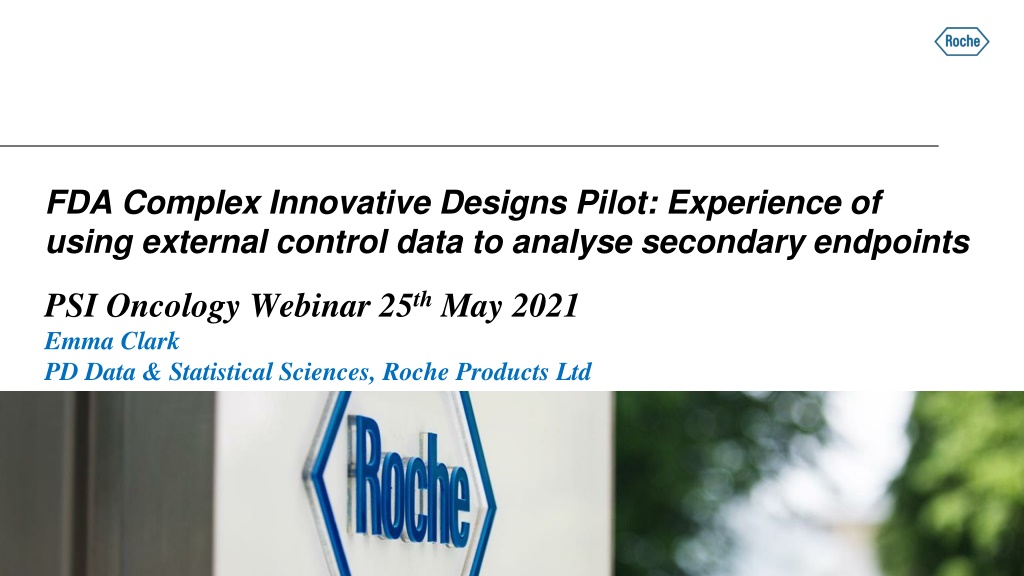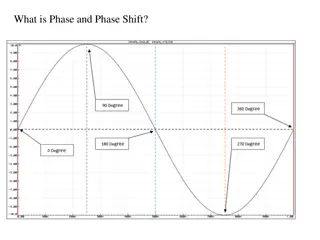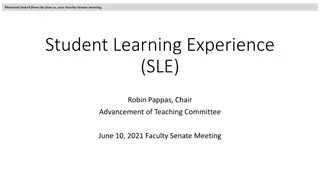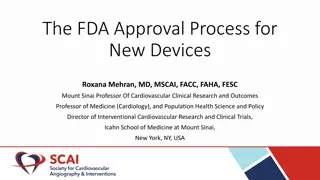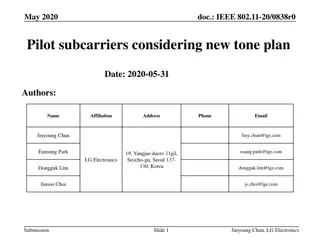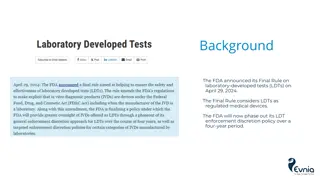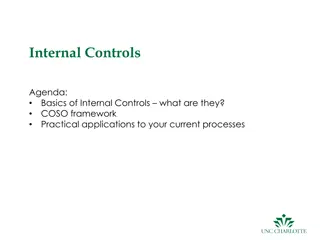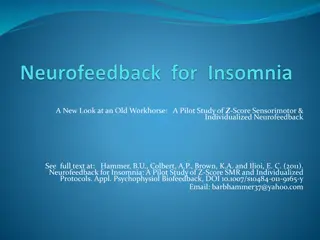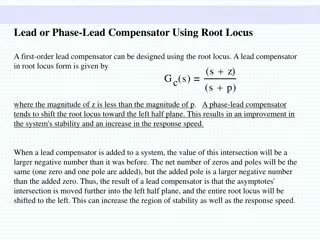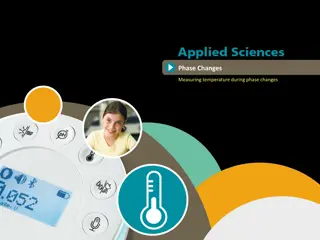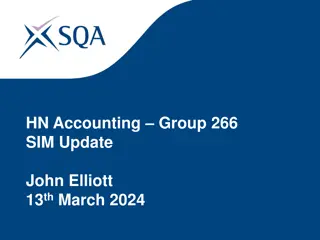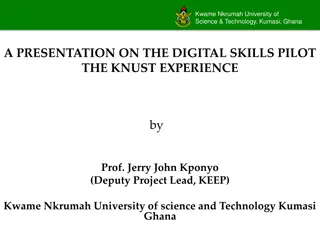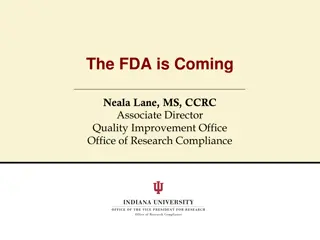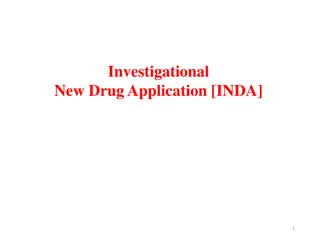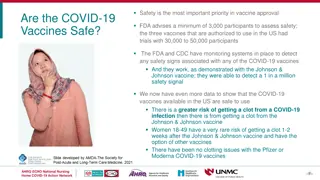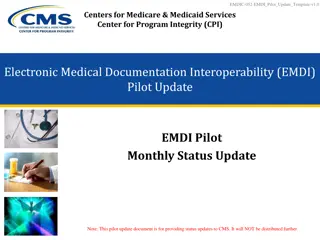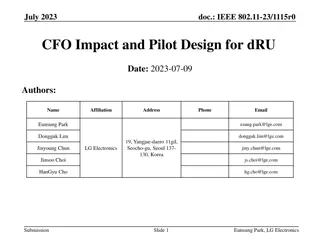Experience in FDA Complex Innovative Designs Pilot Meeting: Incorporating External Controls in Phase 3 Study for DLBCL
Explore the experience of participating in the FDA's CID Pilot Meeting, focusing on designing a Phase 3 study for DLBCL with an external control arm for secondary overall survival. Discover key considerations for future studies with external controls to address high unmet medical needs in DLBCL patients.
Download Presentation

Please find below an Image/Link to download the presentation.
The content on the website is provided AS IS for your information and personal use only. It may not be sold, licensed, or shared on other websites without obtaining consent from the author. Download presentation by click this link. If you encounter any issues during the download, it is possible that the publisher has removed the file from their server.
E N D
Presentation Transcript
FDA Complex Innovative Designs Pilot: Experience of using external control data to analyse secondary endpoints PSI Oncology Webinar 25thMay 2021 Emma Clark PD Data & Statistical Sciences, Roche Products Ltd
Objective Provide an overview of my experience of participating in the FDA s Complex Innovative Design (CID) Pilot Meeting Program Design of a Phase 3 study in 1L DLBCL including an external control arm for secondary overall survival (OS) endpoint Highlight key considerations for future studies incorporating external controls
Background to DLBCL Diffuse large B-cell lymphoma (DLBCL) is the most common non-Hodgkin s lymphoma (NHL) worldwide, with 25,000 newly diagnosed patients in the United States (US) annually. Frontline treatment with R CHOP immunochemotherapy is curative in approx 60% of cases Certain subsets of patients are refractory to (10 15%) or relapse (20 30%) following this 1L standard-of-care (SOC) DLBCL patients with Biomarker+ disease have a poorer prognosis and consequently a high unmet medical need R-CHOP SOC for 1L DLCBL patients established over 20 years ago: it is well characterized and well understood There is a need for new treatments in this area of high unmet medical need
Phase 3 Development in 1L DLBCL & Pathway to CID Pilot Encouraging data from Ph2 study (Experimental + R-CHOP) compared to historical R-CHOP control, especially in Biomarker- positive patients Hybrid control can potentially limit the number of new patients exposed to the well established SOC, and reduce study timelines FDA Type C meeting on proposed Ph3 study in Biomarker+ 1L DLBCL of Experimental + R-CHOP vs R-CHOP (3:1 randomization) plus external borrowed control, selected from contemporary internal study Agency recommended 1 analysis population and analysis plan be based on the randomized trial without an external control: other analysis populations can be used for supportive analyses Focus of updated design on external control arm for secondary endpoint OS, a clinically meaningful endpoint with minimal ambiguity in it s assessment Plan to analyse OS at the time of the primary PFS analysis, with label-enabling potential o Dynamic borrowing of control arm patients to achieve sufficient power for OS endpoint o FDA s CID Pilot Meeting Program provided an opportunity to build on the initial external control discussions within a collaborative framework Scientific discussions across 2 separate TCs o Opportunities for separate email clarification between TCs o
1L DLBCL Proposed Phase 3 Study Design Primary Endpoint: PFS Key Secondary Endpoints - OS, based on randomized patients & matched external control - CR at EOT by FDG-PET, by IRC - EFSEFF, including events primarily due to lack of efficacy - ORR at EOT by FDG-PET, by IRC Randomized study with external control arm using matched external controls through Bayesian dynamic borrowing External control patients to be selected from a contemporary, ongoing internal clinical trial Analysis of primary endpoint (PFS) based on the randomized patients, designed to provide 80% power at the 5% significance level to detect a target HR of 0.6, one IA at 80% of events External control arm intended to support early OS analysis at the time of the primary PFS analysis
Rationale for Source of External Control Arm Prospective plan to select external controls from an ongoing, contemporary, internal randomized controlled clinical trial Consistent eligibility criteria planned Aim to target similar Sites and Investigators to aid similarity OS is a clear and clinically meaningful endpoint with minimal ambiguity in event determination 5 of the 6 proposed criteria outlined by Pocock (1975) for selecting an external control source currently met Receiving a precisely defined standard treatment, the same as for randomized controls Part of a recent clinical study which contained the same requirements for patient eligibility Methods of treatment evaluation must be the same Previous study must have been performed in the same organization with largely the same Investigators There must be no other indications leading one to expect differing results between the randomized and historical controls - Distributions of important patient characteristics should be comparable to those in the new study
Feedback on Labelling Potential of OS with External Controls Statistically significant result Model-assumptions met o Standard analysis typically requires few assumptions o Borrowing: more assumptions + difficult to assess them Pre-specification important What could hamper inclusion of OS in label? o Baseline data comparability o Censoring pattern in both trials o Robustness of the results o Amount of missing data o Outlying subgroup, suggesting the overall result not representative of the full population o Trial conduct, e.g. was randomization correctly implemented o Whether the endpoint was credibly captured in the trial Non-statistical considerations: o Is the summary of analysis clear and easily interpretable by Clinicians o Provides valuable information Ultimately, labelling potential is a review issue, subject to the final data Acknowledging the additional complexity, many of the issues are no different from a standard randomized study
What we learned from the CID program Before CID After CID External controls are usually supplementary material Formally applied for secondary endpoint OS is possible with label enabling potential Not clear on how to formally incorporate it that FDA may accept FDA agreed approach Simulation is required for borrowing, but not clear about the scope and evaluated scenarios Clear FDA feedback on preferred methodology and an established simulation report content map The approach is usually case by case A more general framework that connects clinical knowledge vs. statistical assessment
Future hybrid control study checklist (potential to skip CID) Detailed evaluation of trial operating characteristics and sensitivity analysis Protocol written with simulation report Feasibility check Based on clinical knowledge Unmet medical need SOC situation Control resource* Magnitude of benefit Power under best scenarios when controls are consistent Power under other realistic scenarios Sensitivity analysis with model violations (assuming max type 1 error control) Standard report for easier review from FDA Feedback can focus on disease, external data source SOC related topic Reduce potential back and force on method update (very time consuming) * Expecting quality of RWD will be improved continually in the long run
Considerations for Future Studies with External Controls Disease setting is an important consideration in determining the suitability of a study design for external borrowing o All studies evaluated on a case-by-case basis o Studies in which we historically treat patients in the same way (eg.DLBCL) potentially strong candidates for innovative borrowing approaches External control arm source a key aspect o Our proposal met 5/6 Pocock criteria other RWD sources will likely fulfil less o Aligning between trials on control treatments, endpoint definitions and other operational aspects will improve the quality of available control data for borrowing Sponsors should engage with the FDA as early as possible when considering an external borrowing design FDA has shown an openness to our design with external controls for the secondary OS endpoint, although approvability remains a review issue o An important step towards the future and an ideal state of borrowing for a primary endpoint
Analysis flow diagram Propensity score Propensity score matching Bayesian dynamic borrowing Bayesian dynamic borrowing Control comparability evaluation Control comparability evaluation Apply inclusion/exclusion criteria Flag baseline factors with significant difference between internal and external trials Match patient population between internal and external trials using propensity score matching (PSM) Enhance covariates balance by filtering out unmatched patients A method to: Automatically downweight external control data based on internal/external control agreement Provide inference of treatment effect with hybrid control (i.e. OS analysis) Sensitivity analysis follows main analysis
CID Pilot Meeting Program Complex Innovative Trial Designs (CID) pilot Meeting Program launched by FDA on August 30, 2018 (accepts submissions until June 30, 2022). Provides an opportunity for sponsors to interact with experts from FDA at two meetings designed specifically to discuss their proposed CID. Led by statisticians in FDA s Center for Drug Evaluation and Research (CDER) and Center for Biologics Evaluation and Research (CBER), with participating staff representing relevant disciplines. CID designs include, but are not limited to, complex adaptive, Bayesian, all other novel clinical trials designs which often required simulations to determine the statistical properties of the trial. Examples include: o Innovative use of external data o Formal incorporation of prior knowledge o Inclusion of pre-specified adaptations to multiple aspects of a trial
